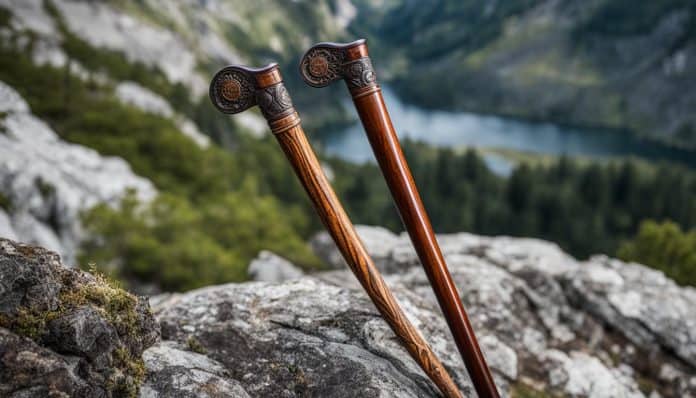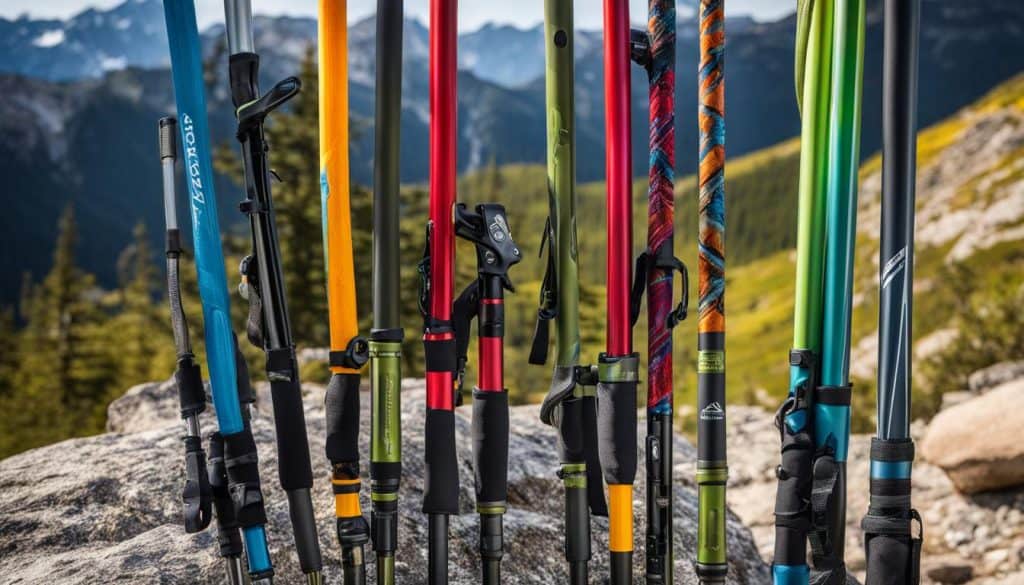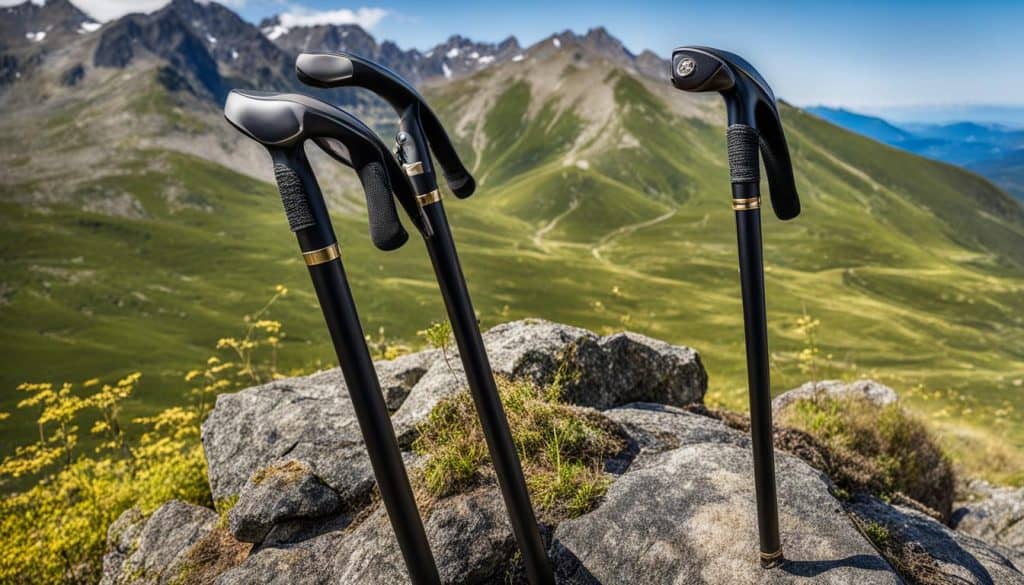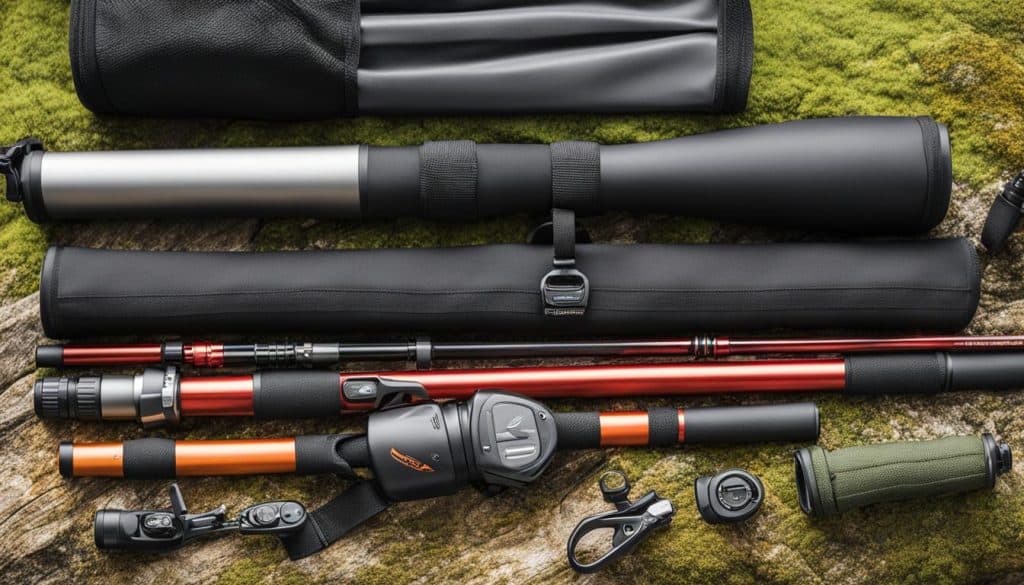
The allure of the great outdoors calls to adventurers with the promise of breathtaking landscapes and thrilling explorations. Essential to this immersive experience is the right camping gear that supports and enriches your journey. Among the myriad of outdoor equipment, walking sticks for hiking have stood the test of time as an indispensable ally for trekkers and hikers. These seemingly simple tools offer a multitude of benefits: beyond aiding with balance and stability, they serve as multifunctional instruments that can transform a strenuous hike into a more pleasurable adventure.
Endorsed by the National Park Service and seasoned hikers alike, walking sticks are not just for forging a path through the rugged terrain; they’re a piece of camping gear that inherently lifts the weight off your shoulders – both literally and metaphorically. Let’s explore how the walking stick, an emblem of outdoor voyages, greatly improves your connection with nature and your efficiency on the trail.
Key Takeaways
- Walking sticks offer stability and support during hiking, reducing strain on knees and ankles.
- They are an integral part of camping gear that can enhance safety by improving hiker’s balance.
- Outdoor equipment like walking sticks is recommended by safety authorities for challenging terrain.
- Real-life testimonials emphasize the walking stick’s role in turning rigorous treks into enjoyable experiences.
- The multifunctionality of walking sticks aids in various tasks beyond hiking, such as setting up camp.
The Importance of Selecting the Right Walking Stick
Recognizing the pivotal role a walking stick plays in the hiking experience, making the right choice is essential for both your comfort and safety. When choosing walking sticks, at sites like Dwight’s Outdoors, it’s about more than just picking the best walking stick available—it’s about finding your perfect trail companion. Several factors determine a good fit, including the hiker’s height, strength, terrain, and specific hiking needs.
According to outdoor survival specialists, the impact of selecting a walking stick that compliments the user’s physical attributes and hiking requirements cannot be overstated. It’s not just about walking; it’s about bolstering hiking performance and preventing injuries. A good fit ensures that the walking stick acts as an extension of the body, leading to a more natural and efficient use of energy.
A comparative analysis by a prominent outdoor magazine emphasized the importance of hiking poles selection by stating:
“The right walking stick reduces the impact on knees and leg muscles during hikes, while a poor match could lead to muscle strain or balance issues.”
Ergonomic studies have shown that different designs cater to different biomechanical needs. These studies guide users in finding a hiking pole they can lean on, figuratively, and literally. For optimal fit, consider the following elements:
- Height of the user – the pole should reach the user’s wrists when the arms hang by the side
- Strength and fitness level – heavier, more robust poles might be suitable for strong hikers
- Type of terrain – adjustability features for diverse hiking conditions
- Packability – easily stowed poles for mixed-terrain hikes
Understanding these elements is not only about ensuring a comfortable hike—it’s about enhancing your connection to the trail and ultimately, to nature.
Types of Walking Sticks Available on the Market

When embarking on a trek, having the right walking stick options can make all the difference in comfort and stability. Today’s market offers a range of hiking poles varieties and each type boasts features catered to specific terrains and user needs. Below, we explore the most common trekking poles types to help you determine which walking stick will best support your outdoor endeavors.
- Traditional Wooden Walking Sticks: Revered for their natural aesthetic and durability.
- Aluminum Trekking Poles: Lightweight yet sturdy, popular among long-distance hikers.
- Carbon Fiber Poles: For the weight-conscious trekker, these poles offer superior strength-to-weight ratio.
- Adjustable Telescoping Poles: Versatile in height, they are a go-to for hikers of all sizes.
- Shock-Absorbing Walking Sticks: Designed to reduce impact on the joints, preferred by hikers traversing rough terrains.
- Foldable Trekking Poles: Compact and transportable, they fit easily into a backpack when not in use.
To help you make an informed decision, let’s compare some of these options more closely:
| Type | Material | Weight | Best Use Case |
|---|---|---|---|
| Traditional Wooden | Wood | Varies | Day hikes, nature walks |
| Aluminum Trekking Poles | Aluminum | Light | Multi-day treks, varied terrain |
| Carbon Fiber Poles | Carbon Fiber | Ultralight | Long-distance treks, mountainous terrain |
| Adjustable Telescoping Poles | Aluminum or Carbon Fiber | Light to Ultralight | All-terrain, adaptable to multiple users |
| Shock-Absorbing Walking Sticks | Aluminum or Carbon Fiber | Light | Rugged terrain, descent-heavy routes |
| Foldable Trekking Poles | Carbon Fiber or Aluminum | Light to Ultralight | Travel, quick hikes, minimal storage space |
Selecting the correct type of walking stick can enhance your hiking experience by providing stability, reducing fatigue, and increasing traction on challenging trails. With the diversity of trekking poles types available, you’re sure to find one that suits your particular needs. Just remember to consider the terrain, the length of your hike, and personal comfort when making your choice.
The Ergonomics of Walking Sticks: Comfort on the Trail
Embarking on a hiking trail can be a thrilling experience that invigorates the soul, but the right equipment is vital to enjoy the journey comfortably. Among such gear, ergonomic walking sticks emerge as a cornerstone for adventurers seeking balance and support on diverse terrains. Delve with us into the ergonomic innovations and personalization options that enhance the functionality of walking sticks, creating a seamless harmony between the hiker and their tool of exploration.
Handle Designs and Grip Comfort
The interface between the hands and the walking stick is crucial, dictating comfort and control on long treks. Ergonomic handle designs, molded to fit the contours of one’s hands, reduce fatigue and prevent the occurrence of blisters or strains. Recent ergonomic research spotlights the significance of a well-designed grip to mitigate forearm strain. Below we contrast the most popular handle shapes and materials, based on user reviews, that contribute to a comfortable hiking pole experience.
| Handle Type | Material | Ergonomic Benefit | User Experience Rating |
|---|---|---|---|
| Cork | Natural Cork | Contours to hand shape over time | ★★★★☆ |
| Foam | Closed-cell Foam | Soft touch & sweat absorption | ★★★☆☆ |
| Rubber | Non-slip Rubber | Shock absorbent & durable | ★★★★★ |
Adjustable Lengths for Personalization
One size does not fit all in the world of trekking, and adjustable lengths embody the essence of personalized trekking poles. Being able to modify the length of the pole ensures that users of varied heights can maintain proper posture, reducing impact on the knees and ankles during ascents and descents. Enhanced adjustability also caters to the changing needs of a multi-terrain expedition, allowing hikers to shorten or lengthen their poles with ease.
Material Choices Influencing Walking Stick Ergonomics
The selection of materials goes beyond mere aesthetics, directly impacting the ergonomic qualities of walking sticks. From aluminum to carbon fiber, material science plays a pivotal role in designing sticks that are both lightweight and sturdy. Balancing the attributes of weight, flexibility, and strength, manufacturers strive to create products that cater to the ergonomic needs of diverse users, ultimately shaping the satisfaction and endurance of outdoor enthusiasts.
- Aluminum: Renowned for its durability and cost-effectiveness.
- Carbon Fiber: Offers reduced weight with high-stress tolerance.
- Wood: Traditional feel with natural shock absorption qualities.
In conclusion, the perpetual innovation in the design of ergonomic walking sticks reflects the commitment to enhance the hiker’s experience with every step taken on the trail. From grip comfort to the materials chosen, these advancements ensure that every hiking adventure can be undertaken with ease, confidence, and a personalized touch.
Walking Sticks and Their Value for Your Camping Trip
Embarking on an outdoor adventure often requires a meticulous selection of gear (camping tents, boots, clothing, etc), with one of the most underrated yet essential items being the walking stick. Known for its array of benefits, walking sticks have evolved from a simple trekker’s tool to a multifunctional implement that caters to various needs on a camping trip. Here are several ways in which these sturdy companions prove indispensable for outdoor enthusiasts.

- Stability and Balance: When hiking with walking sticks, one instantly feels the added stability and balance that manage the body’s weight distribution, especially when carrying a backpack.
- Load Distribution: With each step, the arms and shoulders now share the load that would typically burden the legs and spine, reducing fatigue and allowing for a more prolonged trekking experience.
- Versatility Around the Campsite: Beyond the trail, walking sticks serve as impromptu supports for tent structures, probe for checking ground stability, or even as a measure to ward off wildlife.
Indeed, the camping trip essentials are not complete without the inclusion of a walking stick. Compiling insights from seasoned campers, safety advisors, and professional camping instructors indicates a consensus on the importance of having this tool alongside other camping gear.
A professional camping instructor articulates, “You might think you don’t need a walking stick, but once you experience the difference it makes on your endurance and stability, it becomes as vital as a good pair of boots.”
Whether used for ascending steep paths, fording streams, or furnishing a makeshift shelter, the walking stick adapts to the needs of the camper and the unpredictable nature of the wild. It’s an embodiment of the ingenuity required to conquer the great outdoors.
Embrace the walking stick on your next camping adventure and witness firsthand the myriad of benefits it confers to your outdoor experience.
Integrating Walking Sticks into Different Hiking Terrain
As trekkers embark on diverse expeditions, the adaptability of their gear is crucial for navigating the variances in landscape. Walking sticks prove indispensable for rocky terrain and maintaining stability across challenging trails. With the correct usage of trekking poles, hikers can enhance their stability in hiking, mitigate impacts on joints, and maintain a steady rhythm during their ascents and descents.
Navigating Rocky Paths with Confidence
Rocky paths pose a significant challenge due to erratic footing and loose stones, but with walking sticks for rocky terrain, hikers have the assurance to proceed with confidence. The poles act as extensions of the arms, providing an extra pair of ‘legs’ that improve balance and allow trekkers to test stability before committing their full weight onto precarious grounds.
Maintaining Stability on Uneven Ground
Uneven ground, often encountered on forested trails and mountainous tracks, demands acute body awareness and safety measures. Trekking pole uses in this scenario involve planting them firmly on the ground to create a triangle of support around the hiker, which is key to distributing weight evenly and maintaining stability.
Walking Sticks: Aiding in Water Crossings
Stream and river crossings are an integral part of the hiking experience where trekking poles transform into vital tools. They can be used for probing water depth, finding stable rocks under turbulent water and providing support against the pushing force of the current. It is important to always face upstream and take a side-step approach when making your way across using walking sticks.
Below is an analysis of how walking sticks can influence a hiker’s performance on varied terrain:
| Terrain | Benefits of Walking Sticks | Techniques for Use |
|---|---|---|
| Rocky Paths | Improved balance, reduced fall risk | Scanning ahead and placing poles on stable areas |
| Uneven Ground | Weight distribution, reduced strain on knees | Maintaining triangle of stability with pole placement |
| Water Crossings | Assessing depth, additional stability | Probing ahead, facing upstream, side-stepping |
Understanding the diverse applications of trekking poles across various landscapes not only augments safety but also enhances the hiking experience, allowing hikers to venture into nature with amplified confidence and control.
Weight and Portability: Picking the Best Walking Stick for Long Treks
For avid hikers planning long-distance adventures, the choice of lightweight walking sticks can be pivotal. A walking stick that’s both light and compact can dramatically enhance your trekking experience by minimizing fatigue and making transportation effortless.

Most experienced hikers will vouch for portable trekking poles, especially when facing challenging hauls or multi-day treks. With various innovative materials being used today, walking sticks have become increasingly sophisticated in balancing sturdiness with lightweight design.
- Aluminum poles offer both durability and a lighter weight compared to traditional wooden sticks.
- Carbon fiber models take it a step further, providing exceptional lightness and the ability to reduce vibrations.
- Foldable and telescopic designs make poles portable, fitting easily into or onto a backpack when not in use.
While browsing through long-distance hiking gear, consider the cumulative impact of each item’s weight on your stamina. As per discussions from a backpacking enthusiasts’ forum, every ounce saved from gear can help preserve energy over miles of hiking. In-depth product review videos also highlight that the ease of adjusting trekking poles is just as crucial for adapting quickly to varied terrains.
Hikers’ forums and long-distance hiking guidebooks suggest that an efficient walking stick should balance its physical weight with the weight of its benefits. Therefore, choosing a stick that’s easy to carry but also equipped to handle the unpredictability of nature is key.
Remember, the best lightweight walking sticks for long-distance trails are those that you barely notice during the ascent but deeply appreciate for their support during the descent.
In summary, your selection criteria for an ideal walking stick should center on lightweight attributes, ergonomic comfort, and the adaptability to fold or retract, ensuring they enhance rather than encumber your long treks.
Walking Stick Accessories to Enhance Your Hiking Experience
Embarking on a trekking adventure can be made even more satisfying with the right set of walking stick add-ons. From ensuring your stability across diverse terrains to capturing breath-taking vistas, trekking pole accessories are vital hiking equipment enhancements for any outdoor enthusiast.
Attachable Feet for Various Surfaces
Investing in the right attachable feet for your walking stick can make a world of difference. Whether you’re traversing muddy trails, icy paths, or rocky inclines, these add-ons improve grip and reduce wear. Here’s a quick overview:
- Rubber Tips: Perfect for indoor or paved surfaces and minimizing impact on the terrain.
- Snow Baskets: They prevent poles from sinking into soft ground or snow.
- Carbide Tips: Ideal for rugged outdoor use, offering superior traction on rocky or icy surfaces.
Wrist Straps and Anti-Shock Features
Comfort and convenience should never be compromised when hiking. Wrist straps prevent you from dropping your poles and provide additional leverage, while anti-shock features absorb impact, reducing fatigue on long treks. Consider the following benefits they offer:
| Accessory | Primary Benefit | Ideal Usage |
|---|---|---|
| Wrist Straps | Security and ease of use | Throughout any hiking journey |
| Anti-Shock Poles | Reduces strain on joints | Descents or prolonged hiking |
Camera Mounts for Trekking Photographers
For the hiking shutterbugs, camera mounts are a must-have walking stick add-on. They transform your walking stick into a monopod, stabilizing your shots and helping you capture stunningly clear photographs of your scenic exploits.
Whether you’re a novice hiker or a trail-hardened mountaineer, outfitting your trekking poles with quality accessories can considerably improve your hiking experience. Manufacturers nowadays offer intuitive and user-friendly hiking equipment enhancements, customizing your adventures to your exact needs.

In conclusion, these trekking pole accessories serve more than mere functional enhancements; they represent a dedicated hiker’s commitment to safety, convenience, and capturing the essence of their explorations. Consider these add-ons as investments in your adventure prowess, ensuring that every journey remains memorable and comfortable.
Maintenance and Care for Your Walking Stick
Properly tending to your walking stick not only reflects good hiking equipment maintenance, but it is also crucial in preserving the functionality and extending the life of this vital piece of gear. Seasoned hikers know that caring for trekking poles involves more than an occasional wipe down. Regular cleaning, careful storage, and diligent inspections are the trifecta of walking stick upkeep. By adhering to guidelines provided by outdoor gear maintenance experts, you can ensure that your walking stick remains a reliable companion on all your outdoor pursuits.
First and foremost, after each trek, it is advisable to dismantle your trekking poles if they have adjustable sections and remove any dirt or debris. Pay special attention to the locking mechanisms, as accumulated grit can affect performance. If you’ve crossed saltwater, a thorough fresh water rinse is essential for preventing corrosion. Manufacturer maintenance manuals offer detailed steps for cleaning specific models, often advising on the best cleaning agents and tools to use that won’t damage your equipment.
Regarding storage, remember that a cool, dry environment is ideal. Excessive heat or moisture can warp or degrade the materials of your trekking poles. Before putting them away, make sure they are completely dry to avoid rust or mildew forming, particularly in telescopic poles. Lastly, incorporate a routine check-up of your poles before and after hikes to spot any potential issues such as cracks or worn parts. Many lifelong hikers also share personal anecdotes about the value of a well-maintained walking stick, often recalling how a well-timed repair or replacement of a worn component made all the difference on difficult trails.
FAQ
What features should I look for in a walking stick for hiking?
When choosing a walking stick for hiking, consider factors such as adjustable height, ergonomic grip, shock absorption, weight, and material durability. The National Park Service recommends features that enhance mobility and safety on the trail.
How do I select the right size of walking stick?
The right size of a walking stick is propotional to your height. Hold the stick with your arm at a right angle; the top of the stick should reach your wrist. Ergonomic studies also suggest that a properly fitted stick can prevent strain and injury.
What are the different types of walking sticks available?
Walking sticks come in various forms including traditional wooden sticks, foldable hiking poles, and adjustable trekking poles with features such as shock absorption, terrain-specific tips, and telescoping sections as per the latest industry reports.
Why are ergonomic features important in walking sticks?
Ergonomic features like tailored handle designs and adjustable heights contribute to a comfortable hiking experience by reducing hand and forearm strain, improving grip, and ensuring a correct posture throughout your hike.
How do walking sticks benefit my camping and hiking experience?
Walking sticks provide stability, balance, and support, especially under heavy loads or on uneven terrain. According to outdoor experts, they can also be used to assist with tasks around the campsite and may even protect against wildlife.
Can walking sticks help in all types of hiking terrain?
Yes, walking sticks offer support and confidence on varied terrain, including rocky paths, uneven trails, and water crossings. Being able to navigate such landscapes safely is one of the reasons why seasoned hikers include them in their essential gear.
What should I consider for long-distance treks when choosing a walking stick?
For long treks, opt for walking sticks that are lightweight and portable without sacrificing strength. Long-distance hikers often emphasize the importance of gear that won’t add unnecessary weight or bulkiness to the trek.
What accessories should I consider for my walking stick?
Consider attachable feet for different surfaces, wrist straps for additional security, and anti-shock features for comfort. For those who enjoy photography, camera mounts can be a valuable addition as well.
How do I maintain and care for my walking stick?
Regular maintenance includes cleaning, adjusting any screws or locking mechanisms, and inspecting for wear and tear. Store your walking stick in a dry, cool place and follow the manufacturer’s guidance for specific care routines.












































